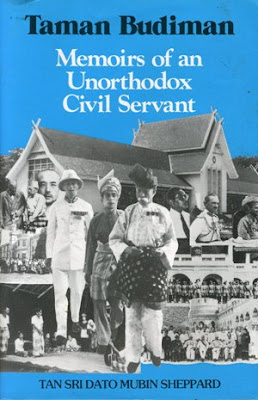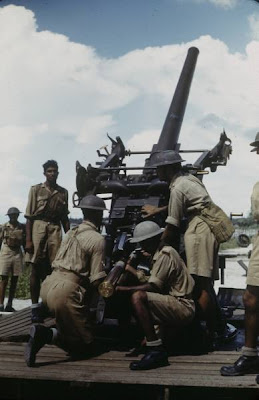
Taman Budiman – Memoirs of an Unorthodox Civil Servant, by Tan Sri Dato Mubin Sheppard
Prisoner & Postman 1938 – 1945
- 1938 – Mubin Sheppard (MUBIN SHEPPARD) was appointed 2nd assistant Secretary to Government in the Federal Secretariat, Kuala Lumpur
- accepted Command of D Company, Selangor Battalion Federated Malay States Volunteer Force (2nd Battalion FMSVF)
- MUBIN SHEPPARD went to Klang and Kuala Selangor every week to supervise training of 3 Malay Platoons and 1 European Platoon (Mainly rubber planters)
- 1938 June, Governor of Straits Settlement, appointed MUBIN SHEPPARD as honorary Aide De Camp (ADC)
- 1939 August, FMSVF HQ held a mobilization exercises for each of the 4 battalions.
- In Selangor, MUBIN SHEPPARD held a Company Rifle Meeting, before attending a Battalion Camp in Port Dickson
- Sultan of Selangor visited the Battalion in camp and dined in the Volunteer Officers Mess. His family members were officers and NCOs of D Company
- 1939, Nov, MUBIN SHEPPARD was engaged and by end of Jan 1940, married the sister of a fellow Malaya Civil Services(MCS) Officer in St Andrew’s Cathedral, Singapore. He was 34 yrs old and the bride, 36.
- 1941 Sep, MUBIN SHEPPARD reported at the District office in Batu Gajah, Perak and took charge of the Land Office- the largest office in Federated Malay States (FMS). Same time, took over command of C Company of the Perak Volunteer Battalion (1st Battalion FMSVF)
- MUBIN SHEPPARD gave top priority to Volunteer training
1941 Oct, Jungle training weekend organized for the company of Malay Volunteers, was met by sarcasm from regular army officers in the Kinta Club Bar
- local sense of complacency about preparing for the war with the Japanese was prevalent
1941 1st Dec, General mobilisation of all troops and volunteers in Malaya was ordered
- MUBIN SHEPPARD told Williams, the District Officer and friends that he would be back to celebrate Christmas. He never saw his house possessions again from that date.
1941 8th Dec, C Company, 1st Battalion FMSVF camped in company tents and in thatched huts on the perimeter of the Ipoh Airfield.
- detachment of Royal Australian Air Force (RAAF) personnel was positioned at the end of the runway with a few small fighter planes and a large stock of fuel
- RAAF also manned telephone exchange, connecting D Company to the town of Ipoh and 1st Battalion FMSVF Volunteer HQ
- Japanese planes had morning and evening bombing raids and dropped anti-personnel bombs on huts and machine gunned trenches, without destroying the runway.
- FMSVF only equipped with Lewis guns with maximum range of 2,000 feet, hence ineffective against Japanese planes
- RAAF withdrew from the airbase one evening, but FMSVF D Company of 4 platoons remained at their posts till 23 Dec 1941 and was ordered to protect the civil engineers that destroyed the runway
1941, 24 Dec, FMSVF D Company handed over the defence posts to a company of Indian Regulars and withdrew to Kampar High School
- a handed typed signal from Military HQ Ipoh was handed to MUBIN SHEPPARD when he has paid the mobilization allowance to his men and was watching the distribution of cooked meal for them on the evening of 24 Dec 1941
- MUBIN SHEPPARD was informed to hand over command to second in command and report to Col Warren at Station Hotel, Kuala Lumpur immediately
- Col Warren was a Royal Marine and was in Singapore 6 months prior to set up a secret school for sabotage operations
- MUBIN SHEPPARD was to join “Stay Behind” parties to be located at the Sungei Lembing to Bundi area, off Kuantan at the East Coast of Malaya
- His duty was to operate wireless transmitters and carry out guerilla operations behind Japanese lines – in anticipation of British counter attacks when reinforcements arrived in Singapore (!)
- Col Warren was finalizing “Stay Behind” parties and has mentioned operatives like Spencer-Chapman, John Davies and Richard Broome
- John Davies was also organizing “Dalforce” which is a company of Chinese Communists from his house in Bellamy Road Kuala Lumpur (?)
1942 9 Jan, MUBIN SHEPPARD was however hospitalized in Singapore General Hospital as he was down with Tropical Typhus
1942 15 Feb, last issue of Straits Times published in the morning – single sheet, tabloid size with caption heading – “Singapore must stand: It shall stand, HE The Governor”
1942 15 Feb, 6pm – General Percival, GOC Malaya Command signed the surrender to the Japanese. 8.30pm, all hostilities ceased.
1942 16 Feb, Morning – Before Japanese take control of Singapore, Leslie Davis, Capt Clement( ADC to the Governor) and MUBIN SHEPPARD drove to the Government House to collect the Governor’s belongings.
- MUBIN SHEPPARD removed the Union Jack Flag which was flying over Government House till 12 Feb 1942. MUBIN SHEPPARD kept the flag sewn inside a sarong, concealed in a pillow case for the whole period of imprisonment and it was hoisted again on the 1st day of release in August 1945. Same year that MUBIN SHEPPARD was conferred a Major rank in the FMSVF
Extracted from Taman Budiman by MUBIN SHEPPARD



